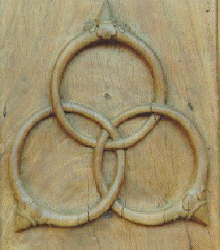- Chem 220 - Organic
Chemistry
Stereochemistry
Chapter 5
Due: Monday, October
5, 2009

|
The
Borremean Rings
Versions of this symbol date to the time
of the Vikings.
In the 15th century, it was the symbol of a tripartite
alliance of the Milanese families Visconti, Sforza and
Borromeo via intermarriage. Break any (wedding?) ring and
the others separate, hence the alliance is broken. The rings
form a chiral
object (left) that is not
superimposable on its mirror
image. A set of Borremean rings
has been used as the logo for a certain refreshment that
extols purity, body, and flavor. Is the sense of chirality
of the two sets of Borremean rings the same or different?
For some other discourses on chirality, see:
Potpourri
The Figure 8
Knot
Gentlemen's
Neckties
Molecular
Knots
Snails and
Crabs
Snails, Snakes and Darwin (html)
1
2
(pdf) 1
2
|

|
Read the stereoisomers
module in the StudyAids and do the
exercises. There is no need to record answers on your
homework.
Don't forget the Chirality
of Shells (Powerpoint). Do
left-handed whelks have a better survival rate than their mirror
image brethren? Click here.
|
1. When
(R)-1-chloro-2-methylbutane undergoes free radical
chlorination, five dichloro constitutional isomers are
formed. What are these structures? Draw them. Be explicit as
to diastereomers, enantiomers, racemates, etc.
|
|
2. There are twelve possible Fischer
projections for a given enantiomer of ±-chloropropionic
acid. Six of the 24 of the total are shown below.
Assign R,S-configurations to each one. Draw the
remaining (S)-enantiomers.

|
3. A 3:1 mixture of enantiomers has
[±]D = -60o. What is the rotation
of the d- and l-enantiomers? Show work.
|
4. a) 1,2-Dibromoethane is optically
inactive yet it has a dipole moment. Explain and illustrate.
[Hint: Draw the staggered conformations and assess
optical activity and dipole moment for each.]
b) meso-Tartaric acid exists in three staggered
conformations, none of which has a plane
of symmetry. Yet the compound is
optically-inactive. Indeed, the only conformation that has a
plane of symmetry is quite unstable. Explain and
illustrate.
|
5. Which of the following compounds are, in
principle, capable of resolution? Explain and illustrate. [For
3-D Jmol views of these structures click here.: 5a,
5b,
5c,
5d,
5e,
5f.]

|
6. (S)-±-Phellandrene
([±]D = +86o) is a
monoterpene with the characteristic fragrance of dill.
(S)-±-Phellandrene reacts with 2 moles of
hydrogen gas in the presence of Pd to give two cyclohexanes
A and B, both of which have the formula
C10H20 and both of which are optically
inactive. Compound A has an energy difference of 0.3
kcal/mol between its two chair conformations while compound
B has a value of 3.9 kcal/mol for the same
equilibrium.
Explain the loss of optical activity, the energy
differences, and identify the structures A and
B.
|
|
7. (R)-±-Phellandrene has
been reported to have a specific optical rotation of
-217o. This observation suggests that the sample
of the enantiomer used in problem 6 above is contaminated.
Assume that the contaminant is the (R)-enantiomer and
that the (R)-enantiomer is pure. What percentage of each
enantiomer is present in the sample of problem 6? Show
work.
|


